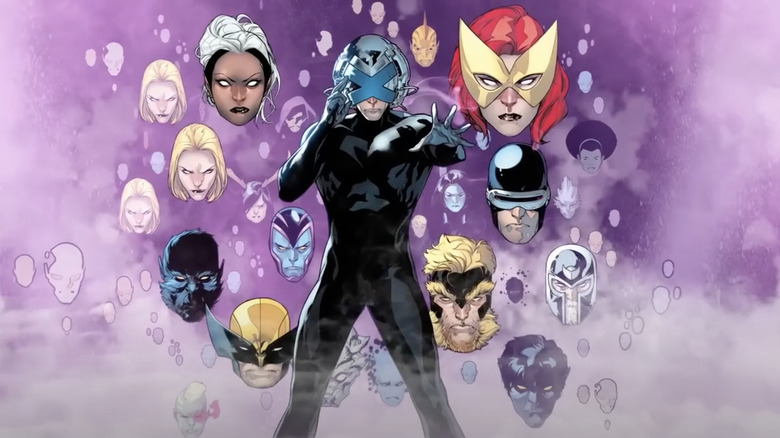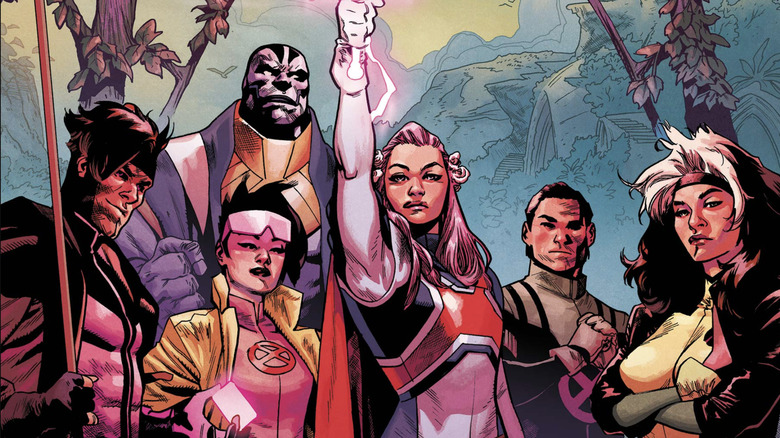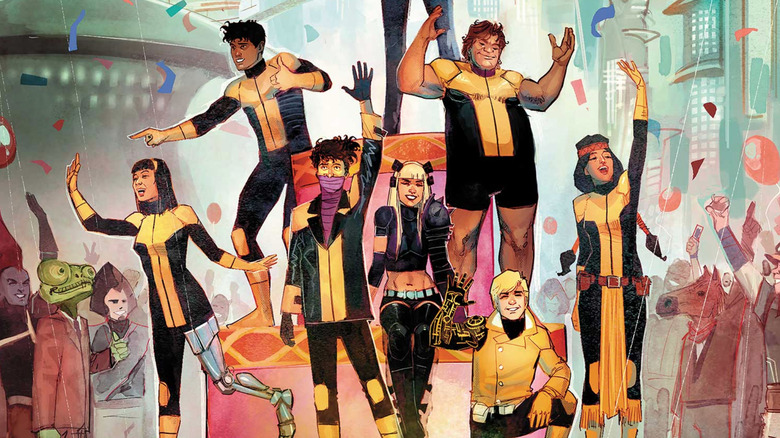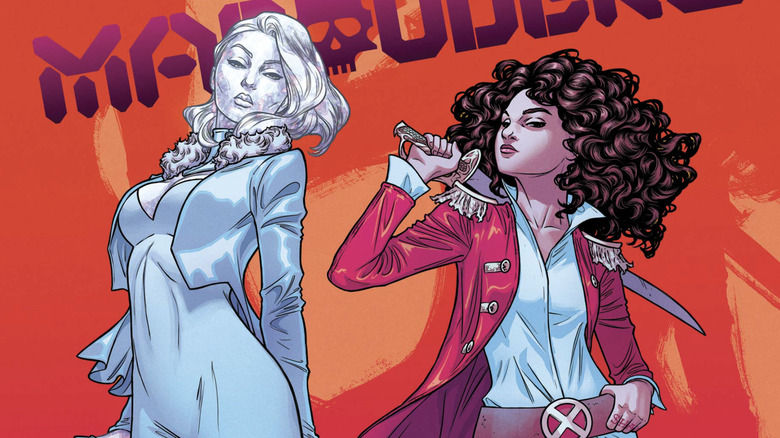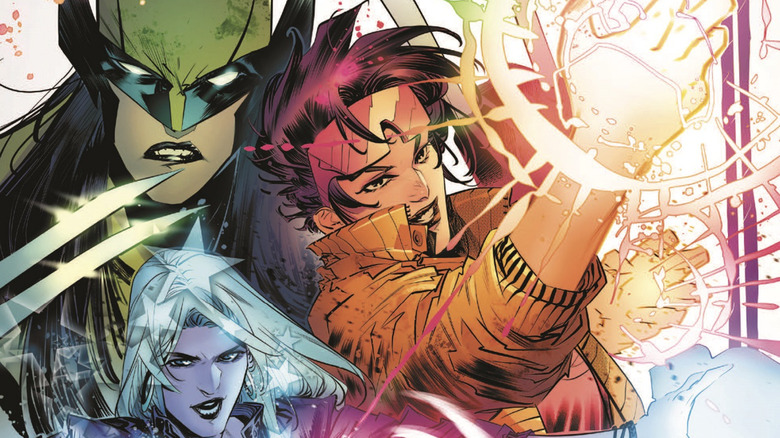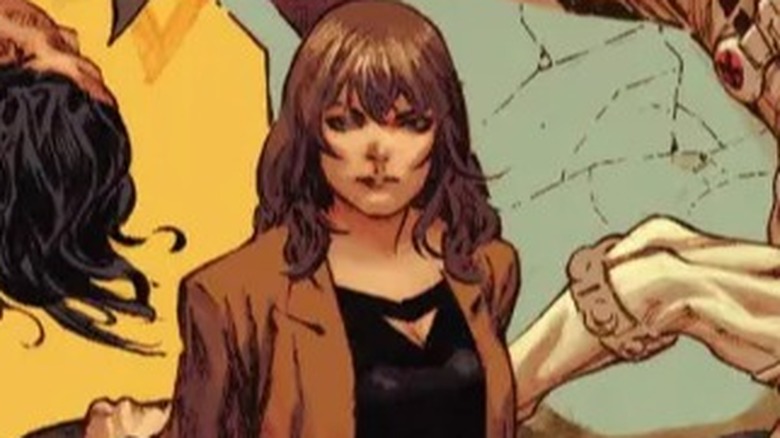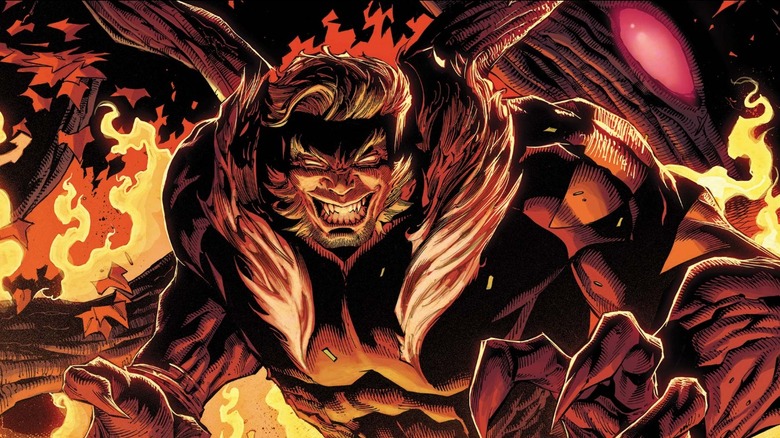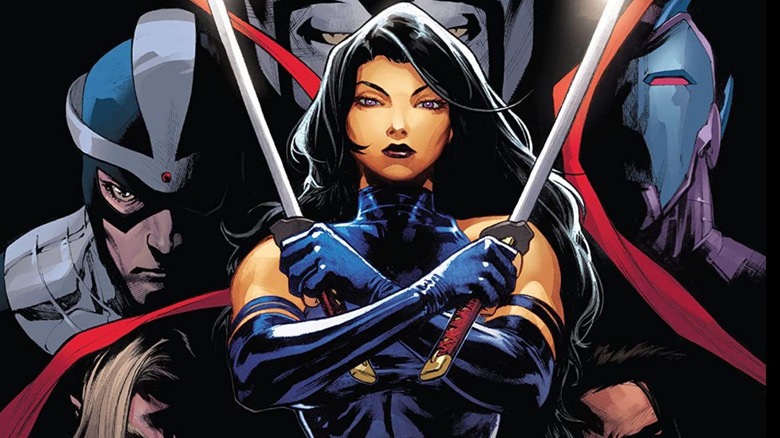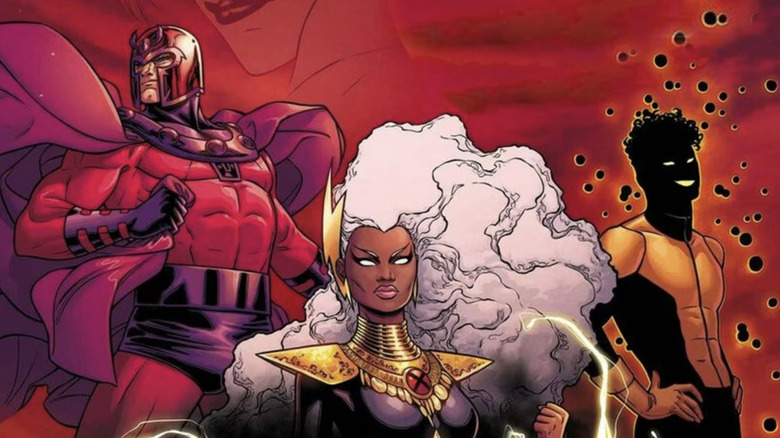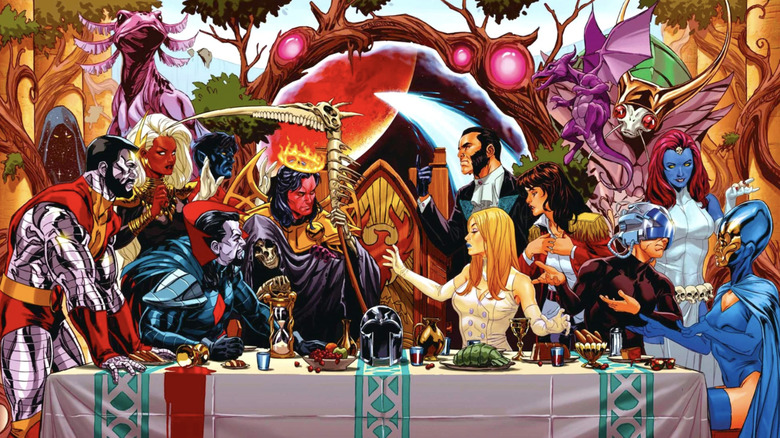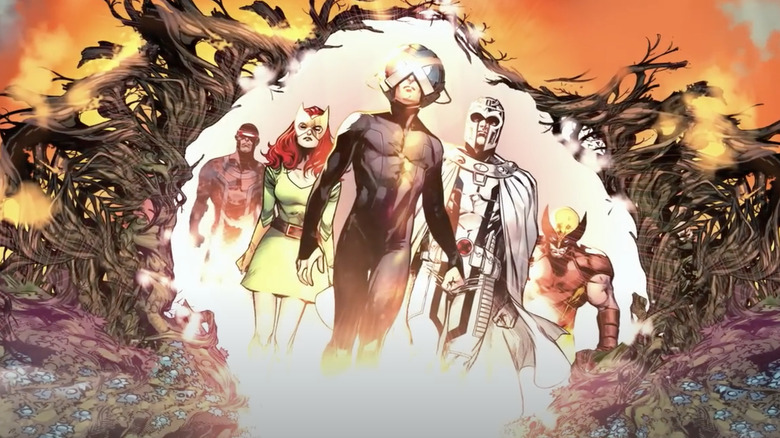The 10 Best Marvel Comics From The X-Men's Krakoa Era, Ranked
The X-Men comics' "From The Ashes" era banks on the 90s nostalgia that made the recent "X-Men '97" revival such a success. This safe approach, though, comes off (and undoes) one of the most experimental periods in "X-Men" comics ever: the Krakoa era.
"X-Men" has a premise that could be a straightforward science-fiction story, no capes needed, but most of their stories lean more on soapy interpersonal drama than big ideas. Krakoa titled that balance in the other direction. This new dawn for X-Mankind kicked off in 2019 with interlocking miniseries "House of X" (written by Jonathan Hickman, art by Pepe Larraz) and "Powers of X" (also written by Hickman, drawn by R.B. Silva) and concluded in 2024.
"Krakoa" is the name of a South-Pacific island where Professor X, Magneto, and Moira MacTaggert create a homeland for all mutants (even the bad guys). Mutants proclaim themselves the next step in human evolution and now that they're one people, they prove that by outpacing human achievement. They build a teleportation network, put their powers together to conquer death, and terraform Mars into a second world that they don't have to share with humans.
Stylistically, the comics also have "data page" inserts, which offered exposition and world/character-building annotations in pure black-and-white. Such pages are a Hickman trademark (he thinks it saves space for the illustrated comic pages to focus on the story) and the writers who came after him aped it.
The Krakoa era is sprawling; it's fitting that plant biotechnology is a big part of the aesthetic since the setting spread like a garden. So, here's the best comics of the bunch. These are not necessarily the most consequential titles, but the ones you'll most enjoy reading.
(These comics can all be found on digital reading service Marvel Unlimited.)
10. Tini Howard's Magical Mutants (Excalibur, X of Swords, Knights of X, and Betsy Braddock: Captain Britain)
"X-Men" has big ties to the "Captain Britain" series. Brian Braddock, the most famous Captain Britain, was created by longtime "X-Men" writer Chris Claremont (plus artist Herb Trimpe). In the 1980s, Claremont wrote "Excalibur," about the eponymous team (led by Captain Britain and featuring the X-Men Nightcrawler and Shadowcat). The X-Woman Psylocke is also Brian's sister (Betsy Braddock).
Captain Britain is not a roided-up super-soldier like Captain America. He's Britain's mystically chosen guardian, with powers tied to the realm of Avalon. The Krakoa-era "Excalibur" (written by Tini Howard, drawn by Marcus To) focuses on Betsy being chosen as the new Captain Britain. In her company are Rogue, Gambit, Jubilee, the earth-shaking Rictor, and ... Apocalypse?! Yes, En Sabah Nur is a Krakoan citizen (he's even part of its ruling Quiet Council), for he sees no reason to oppose the X-Men now that they've finally accepted mutants' destiny of dominion.
"Excalibur" is the most fantastical and adventurous of the initial Krakoa titles, taking its mutant characters into the realms of sorcery and unearthly realms. What puts the series over the top is that it's the "X of Swords" crossover's backbone. Krakoa is challenged by Arrako, a civilization of mutants from the demon realm Amenth, and must choose 10 champions for a series of contests (the winning team gets Earth). This story is a swashbuckling blast, one that feels more like a manga-style "tournament arc" than a traditional superhero crossover.
"X of Swords" offers a decent off-ramp for "Excalibur." If the first 12 issues hook you, though, there's 26 total. Howard then kept the story going with miniseries "Knights of X" (drawn by Robert Quinn) and "Betsy Braddock: Captain Britain" (drawn by Vasco Georgiev).
9. New Mutants by Vita Ayala and Rod Reis
"New Mutants" is the least consistent ongoing Krakoa title, for it had a succession of several writers/artists across its 33 issues. The strongest run was written by Vita Ayala and primarily drawn by Rod Reis. The issue numbering doesn't change (their run is #14-28), but the collected editions reset to Volume 1.
Debuting in 1982, "New Mutants" was a book about Professor X (and then a reformed Magneto) teaching the next generation of mutant heroes. Charles Xavier calls his X-Men students, but at the time, the only one young enough to be in school was Kitty Pryde.
Ayala and Reis pass the baton once more. Those OG New Mutants (Magik, Mirage, Karma, Wolfsbane, Warpath, and Warlock, plus the later-created Armor) are put in charge of supervising the mutant youths living on Krakoa, giving them guidance and structure to their lives. Unfortunately, they soon find themselves competing with another mentor who's swayed some young Krakoans: the evil psychic Shadow King. The old militant ways of mutant teaching may not be enough — this next generation needs something new.
"New Mutants" has some of the most compelling data pages. Warpath is given a journal to write about therapy prompts ("Do you think of yourself as optimistic or pessimistic," "I deserve to be happy because?", etc.), and the written answers are often cutting. On the art side, Rod Reis does a cover of Bill Sienkiewicz, whose abstract art is what elevated the original "New Mutants" run above its "X-Men Babies" origins.
8. Marauders by Gerry Duggan
X-Men pirates. Does that sound like fun to you? Look no further than "Marauders."
Due to a quirk of her intangibility powers, Katherine Pryde (once nicknamed Kitty, now Kate) can't use the Krakoa portal network. Emma Frost has turned the Hellfire Club into the Hellfire Trading Company, Krakoa's largest corporation that distributes life-saving drugs across the globe (all part of a plan to buy mutants' way into the human world order). So, the two team up: Emma gives Kate a ship and crew (Storm, Bishop, Iceman, and Pyro) to sail the globe, rescue mutants from countries that don't recognize Krakoa, and bring them home. This shipping company, Emma proclaims, will be a force of liberation, not the slave trade.
The book, written by Gerry Duggan, employs a couple different artists (first and foremost Matteo Lolli). The covers, though, are always gorgeously drawn by Russell Dauterman. The pages inside are pretty good too. Emma and Kate have a lovely dynamic: once enemies, now mentor/mentee. They are unquestionably the stars of "Marauders" and the book focuses much on their power struggles with Sebastian Shaw, the Hellfire Company's Black King — so much so that it gradually slips away from its initial pirate premise. "Marauders" could do with a bit more one-off stories about Captain Pryde and her Marauders having adventures on the high seas.
The initial run, though, is one of the highlights of "Dawn of X" (it basically wraps up with issue #16, where Kate and Emma — wise to Shaw's machinations — blackmail and beat the s**t out of him). What I can't recommend is the relaunched "Marauders" by Steve Orlando, which does away with corporate politics for stories about prehistoric mutants.
7. X-Terminators
Essential reading doesn't just mean "narratively consequential." See: "X-Terminators" by Leah Williams and Carlos Gómez. Does it have much bearing on the larger ideas or arcs of the Krakoa era? Nope, but it doesn't need to.
Mutant pop star Dazzler discovers her boyfriend Alex is cheating on her. So, she kicks him out and plans a night out with Jubilee and Boom-Boom. Too bad it turns out Alex was a vampire, and he and his buddies want revenge for Dazzler smashing his record collection in anger. Cue the three being thrown into some vampire death traps and teaming up with Wolverine (Laura Kinney/X-23, not Logan).
"X-Terminators" (initially pitched as "Dazzler The Vampire Slayer" and then "Grindhouse of X") is hilarious and pure fun, especially during the framing device of the four leads having to explain their ridiculous night to the Quiet Council. Even the data pages get in on the book's "gleefully transgressive" mood. There's no weighty exposition, but there are some screenshots of the X-Women's group-chat.
Leah Williams is the heir to Gail Simone as the foremost writer of funny and sexy superhero comics. She proves it with this epic of horny and boozed-up X-Women slaying some fanged a-holes.
6. Jonathan Hickman's X-Men (X-Men, New Mutants #1-7, Giant-Size X-Men, and Inferno)
After "House of X"/"Powers of X," Hickman started as the writer of the main "X-Men" title (he also penned the opening issues of "New Mutants" alongside Ed Brisson). His run was structured like an anthology, with different issues spotlighting different characters or corners of Krakoa.
The highlights of Hickman's run are undoubtedly issues #4 and #7, both drawn by Leinil Francis Yu. Issue #4, "Global Economics" is about Professor X, Magneto, and Apocalypse going to Davos and throwing Krakoa's new weight around in front of the global elite. Issue #7, "Lifedeath," is about the Crucible — a Krakoan ritual where a depowered mutant must fight and die in single combat to be resurrected whole. Hickman's work often spotlights the ugly work that running a nation takes and these issues are the ones that most explore the darker side of Krakoa.
Hickman also wrote five "Giant Size X-Men" one-shots. My favorite is the mostly dialogue-free one focusing on Jean Grey and Emma Frost (drawn by Dauterman) as they telepathically enter Storm's mind to find the source of an illness in her. (The issue homages the similarly silent issue of "New X-Men" #121 by Grant Morrison and Frank Quitely, and both force the reader to glean meaning from the images without words to guide them).
Hickman capped off his time on "X-Men" with four-part mini-series "Inferno" (drawn by Valerio Schiti). The story caps off one of his initial X-Men storylines, about Mystique trying to get her mutant wife Destiny resurrected. In "Inferno," she succeeds and lays bare some of Xavier and Magneto's buried secrets for all of Krakoa to see.
5. Sabretooth
I know what you're thinking: Sabretooth, Wolverine's even more aggressive nemesis? What could make a book about him so special?
Well, this one is written by Victor LaValle, an accomplished horror novelist. (I highly recommend his novella "The Ballad of Black Tom," a revisionist take on H.P. Lovecraft.) It's generally a good sign when a prose writer enters comics because their past resume means they tell stories that have something to say; they're not writing just to play with their favorite action figures. "Sabretooth" (drawn by Leonard Kirk) is that, focusing on how a supposed paradise like Krakoa still falls into old human habits about justice.
Krakoa has three laws: Kill no man, respect this sacred land, and make more mutants. In "House of X"/"Powers of X," Sabretooth breaks the first law. So, he's condemned to the Pit, an underground chamber in Krakoa that keeps him in living death. The sentencing was framed as the first sign of the moral compromises that running Krakoa would take and LaValle picks up on that. Is a nation really a utopia when only those who fit its desired parameters are let in?
Prisons aren't vehicles for restorative justice, they're places to keep those society deems "undesirable" or irredeemable out of view. Krakoa's is no different. Sabretooth gets to live in an astral paradise (his Heaven, though, is Hell for everyone else) but is denied true freedom. When five more prisoners join him in the pit, they begin plotting an escape.
LaValle continues his story in "Sabretooth and the Exiles" then concludes it (alongside Ben Percy) in the "Wolverine" storyline "Sabretooth War."
4. Hellions
When he's not mucking up Spider-Man's love life, Zeb Wells can be a skilled writer. He proves it on "Hellions" (art by Stephen Segovia), which, like the later "Sabretooth," is a book about Krakoan justice.
Cyclops' brother Havok and a bunch of miscreant nobodies (Empath, John Greycrow, Wild Child, Nanny, and Orphan Maker) violate Krakoa's laws. Instead of throwing them in the Pit, the Quiet Council puts them under the purview of Mister Sinister/Nathaniel Essex (who, yes, also got amnesty in Krakoa; his mutant DNA database is critical to resurrection) and the other Psylocke (Kwannon). The book asks if these anti-heroes can move beyond dysfunction.
"Hellions" is a book about forgotten mutants. Havok is always in Cyclops' shadow, Kwannon had her life stolen by Betsy Braddock for years, and the first villain is Jean Grey's clone Madelyne Pryor. Yet Wells makes you care about each and every one of them (and hate Sinister even more for how he glibly manipulates them all).
"Hellions" is also one of the most self-contained Krakoa books, with only 18 issues and a definitive ending. (Issue #5-6 are part of "X of Swords," but the focus is on the Hellions themselves and the crossover's context is neatly spelled out).
3. Al Ewing's Cosmic X-Men (S.W.O.R.D., X-Men: Red, and Resurrection of Magneto)
After Hickman's departure, Al Ewing emerged as one of the key voices of Krakoa. His "X-Men" titles focus on the mutants' efforts to make themselves into galactic power players. S.W.O.R.D. — run by Abigail Brand — is like S.H.I.E.L.D. but keeps Earth safe from intergalactic threats, not domestic ones. Ewing's "S.W.O.R.D." focuses on Brand and her organization colluding with Krakoa to make Earth's solar system into a power player.
Brand is one of the key characters across Ewing's series, alongside Storm, Magneto, and Sunspot. "X-Men: Red" focuses on those three resettling on Mars, colonized by mutants from Arrako, and learning how to live in a different, more Darwinian civilization. Storm grows into no longer just Queen of Lightning, but also Queen of Mars.
Ewing knows how to do jaw dropping twists and the ending of "S.W.O.R.D." and midpoint of "X-Men: Red" are some of the most applause-worthy reveals I've read in recent comics. He caps off his "X-Men" with 2024's "Resurrection of Magneto" (drawn by Luciano Vecchio), the indisputable highlight of "Fall of X." Ewing brings his two leads together once more when Storm journeys into the afterlife to bring Magneto back. You don't really need to know the big picture though, because "Resurrection" is a character study first, looking at the different personas both Storm and Magneto have worn and how those fragments can add up to a whole.
Magneto began "X-Men: Red" in retirement and in "Resurrection," he's content to burn because he believes his legacy is blood. Does his anger's righteous roots mean anything when he's piled up so many bodies because of it? If he gets a new lease on life, which Magneto will he choose to be?
2. Immortal X-Men
"Hellions" doesn't mark the end of sassy Sinister; he continues on in "Immortal X-Men" under Kieron Gillen's pen (the writer who first remade Sinister into a campy drag queen without the queen in 2011-2012's "Uncanny X-Men"). Gillen is the Krakoa writer most in line with Hickman's vision. He picks up the idea of "Dominions" introduced in "House of X"/ "Power of X" — that as civilizations evolve, they inevitably move away from individuality. This made him perfect to write a book about the Quiet Council, the compromised leaders of Krakoa.
These days, pretty much every fantasy fiction with a focus on palace politics gets compared to "Game of Thrones." Similar to how George R. R. Martin writes each chapter of "A Song of Ice and Fire" from a different character's POV, Gillen writes every issue of "Immortal X-Men" focused on one of the Quiet Council's 12 members.
My favorite is issue #10 (drawn by Lucas Werneck), which Professor X narrates. He monologues about how mutants are as dangerous as the worst of humanity thinks, which is why he's spent his life working to protect them from themselves. The world needs someone like him, Charles argues — a long-term idealist but a short-term realist, and one with enough restraint to use his awesome power for good.
To convince the reader of his argument, he shares his darkest secret, seven words that turn hope sinister: "There will never be a nuclear war." Charles used his powers to plant a psychic block in anyone and everyone who could start such a conflict. If he wanted to, he could be much more controlling. (Be thankful, he says, that Magneto was not born a telepath.) But he's a teacher at heart, who wants to win hearts and minds the old-fashioned way.
1. House of X/Powers of X
It can't be anything else. "House of X/Powers of X" are rare Marvel superhero comics that feel revolutionary. Hickman recontextualizes, rather than repeats, old stories in a way that honors them but expands the possibilities.
His biggest retcon is that Moira, previously depicted as a human scientist, is actually a mutant herself with the gift of reincarnation. When she dies, the timeline resets to the moment of her conception and she retains all her memories. She's lived 10 (or as the Romans would write, X) lives and watched mutants fail in all of them. Krakoa is her latest effort and while "House of X" is all about mutants remaking the world, "Powers of X" underlines that hope with the suggestion it may be yet another forthcoming crash and burn.
"House of X/Powers of X" are books all about perspective; we're accustomed to treating the X-Men as heroes, but how far can they push that envelope before it changes? Are they now villains because they prioritize their own people over those who hate and fear them? Anti-mutant organization Orchis thinks they're the heroes; they are fighting to save humanity from an invasive species, after all. (Hickman's "Avengers" was about the Illuminati blowing universes to save their own; unlike many Marvel writers, he always avoids easy answers.)
Adding to that, Hickman, Larraz, and Silva will sometimes use the same images twice, with a different context each time. Both "House of X" #6 and "Powers of X" #6 end with a celebration on Krakoa and Magneto marveling "Just look at what we have made" — but the latter adds two extra pages where Erik adds "Is it enough?"
The Krakoa era as a whole was hit or miss when it came to changing the X-Men's world, but "House of X"/"Powers of X" hold up.
